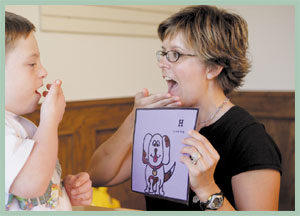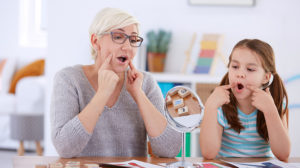Overview:
The auditory-oral approach to therapy or education involves exactly what is seems – highlighting auditory input and speech in order to aid language acquisition in the Deaf and Hard of Hearing. It is similar to techniques used in typical speech therapy, but with the added component of auditory amplification (see Hearing Technology) as needed. The oralism aspect allows deaf children to open their world of communication beyond the limited numbers of people who are fluent in a sign language. With the proper resources and practice, deaf children are capable of remarkable advances in speech, to the extent that some people may not even notice something different at hand. However, success in oralism is quite varied, as indicated in children with a “Deaf accent” or some whose speech is overall unintelligible. This approach places large emphasis on parent-child interaction; caregivers are expected to further promote language development outside of the clinic or classroom by engaging children in conversation and working towards set goals in the home environment¹. Note that this approach typically forbids any sort of sign language, and in some cases, lip reading.
Pros and Cons:
Pros:
- Increased family involvement in child’s education, and family gets to communicate in their own language.
- Allows for far greater interaction in society and friendships with typically developing peers.
- Improved skills in the English language.
- Helps lip reading.
Cons:
- Sometimes frowned upon in the Deaf community, which embraces sign language.
- Possible feelings of disconnect from other deaf children.
- High parent or family involvement is absolutely essential to the process.
- If attempt in unsuccessful and another language is not introduced in childhood, language loss is possible.
- Speech intelligibility varies.
The Stigma on Oralism:
The Deaf community is a cultural minority in society, and sign language is often associated as the natural way for Deaf people to communicate. Most oral approaches completely ban all forms of gestural communication, restricting the ability of Deaf children to communicate in what is considered to be their native language. Oralism is thought to strip children of their Deaf identity and mold them to fit in with hearing people. While “Oralism” as it was used in the 1860s is no longer used, the auditory-oral approach largely relies on lip reading, speech, and listening. One problem with this approach is that families occasionally view this as a method of “fixing” their Deaf preschooler and making them able to communicate “normally.” For example, I once had a parent move their profoundly deaf preschooler (though slightly above the preschool age), fluent in sign language and with no oral background, to an oral classroom solely so the parent would not have to learn sign language. While the parent maintains this right, the child faces extreme delays in spoken language and is unable to use her native sign. She is frustrated easily and cannot communicate her thoughts effectively.
The Oral Approach and Language Acquisition:
Naturally, the oral approach places large emphasis on developing spoken language, though it also relies heavily on comprehension of auditory input. Together, these cover receptive and expressive language.
One way in which this approach promotes language acquisition in preschoolers is through modeling, which draws upon receptive language skills and progressively improves speech. This can be done visually, using auditory stimuli, or tactile methods.

- Visual: In replicating a sound, and eventually, a string of sounds, a child must be able to produce the correct sequence of articulator movements corresponding to the target phonemes². This can be learned through observation of the correct vocal and nasal arrangements necessary in sound production via an instructor. Some instructors use a mirror or point to throat and mouth movements when creating a sound in order to draw attention to the necessary components. The child can then use the mirror and practice using the same articulator movements to replicate the modeled sound or sounds.
- Tactile: Similar to the visual approach, the child draws upon knowledge of the modeled sound to produce it. In the tactile method, children are encourage to feel the throat of the instructor or therapist in order to feel the location and source of the vibrations. Again, they then replicate the action with themselves and attempt to produce the same sound by mirroring the vibrations originally felt.
- Auditory³: This approach relies solely on auditory input and comprehension to provide a model for deaf children. Whether it be an instructor speaking (usually through an FM receiver) or a recording, the student is expected to listen closely and attempt to produce the same sound based on the stimulus.
Though modeling is only one method used in oral therapy, it exemplifies the interaction between auditory input and the gains that can be made in receptive and spoken language. While it can aid in vocabulary gains, syntax is more complex and requires a larger foundation than what is provided by the oral approach at preschool levels.

Oral Classrooms and Education:
Outside of one-on-one therapy, the oral approach can be used in the classroom as well. Typically involving smaller classroom sizes between 4-12 students, children in these environments are split by spoken language abilities so as to place focus on language goals that apply to the group as a whole⁴. Note that these classrooms usually employ FM receivers that direct speech from the instructor’s microphone directly to the processors of the students’ cochlear implants or hearing aids.
Because individual techniques are not possible in the classroom setting, activities in this environment tend to involve “going around the circle.” The staple, every-week activity would be to read a new story (add some pep and relate it to a weekly classroom theme!) and base the week’s goals on the story.
Say the theme was the animals, and the story depicts the escape of zoo animals into the city. A popular method here is for an instructor to read the story aloud and prompt comprehension questions along the way (“What animal leapt over the gate?” The monkey). The teacher can then pass around her microphone and encourage each student to repeat the answer to the question until they can each pronounce it correctly (the -key in monkey would be extremely difficult for lower level oral students to pronounce). Because they speak into the microphone, the student can hear their speech amplified into their hearing devices and adjust accordingly. Later in the week, the teacher may prompt students with pictures of a monkey and have students practice making the connection between the story and the words or sounds as well as producing the speech correctly. Note this process is highly variable between higher level and lower level auditory-oral classrooms.
Because the oral approach is aimed towards spoken language, repetition is a key feature of the method.
Sample Activity: Pirate’s Booty Speech
The following activity, adapted from the Peachie Speechie, works towards the goal of producing the “a” sound as found in “are” or “card.”

Each coin in the pirate’s treasure chest contains a word with this target sound. The word may be spoken aloud by the instructor or read by the student, depending on the level of the student. When the student is successful in producing the word, they are able to color in the coin containing that word and continue until all coins are colored. Then, the child can color in the rest of the picture (great motivation for younger kids).
Notes:
1 – Home Environment; According to Bronfenbrenner’s Ecological Perspective of social development, the relations between home and school make up a social group in the mesosystem, which involves natural links between two social settings. Bronfenbrenner suggests that these relationships promote individual social development. Thus, the importance of communication between child and caregiver lies not only in language development, but in social development as well.
2 – Phonemes; Phonemes are the smallest units of sound into which language can be broken. In the oral therapy approach, in which the goal is accurate spoken language, phonemes play a large role in speech. It is extremely difficult for Deaf children to put sound units together, but this is why the tactile and visual methods for phoneme attainment are useful – they help children to identify the correct movements in producing a specific phoneme.
3 – Audition as a sense for learning in the sensorimotor stage; According to Piaget’s stage theory, the sensorimotor stage involves the primarily role of the sense in establishing a connection to the physical world, which aids in cognitive development. The (typical) lack of auditory stimuli at this age means that preschoolers face consequent difficulties in drawing connections between the physical world and sound. For example, a deaf child who received hearing assistance at age 4 is usually unable to assign sound to a source or location. This is because their sensorineural hearing loss did not allow proper attribution of sound in the sensorimotor stage.
4 – Cooperative Integrated Reading and Composition (CIRC); The CIRC approach in preschool and early elementary education is used to group students in groups of four and work on various activities that promote literacy. This most closely resembles the set-up in most oral classrooms I’ve witnessed, and assists the students in collaboration. The students are able to monitor each other’s pronunciation, vocabulary, and grammar.
